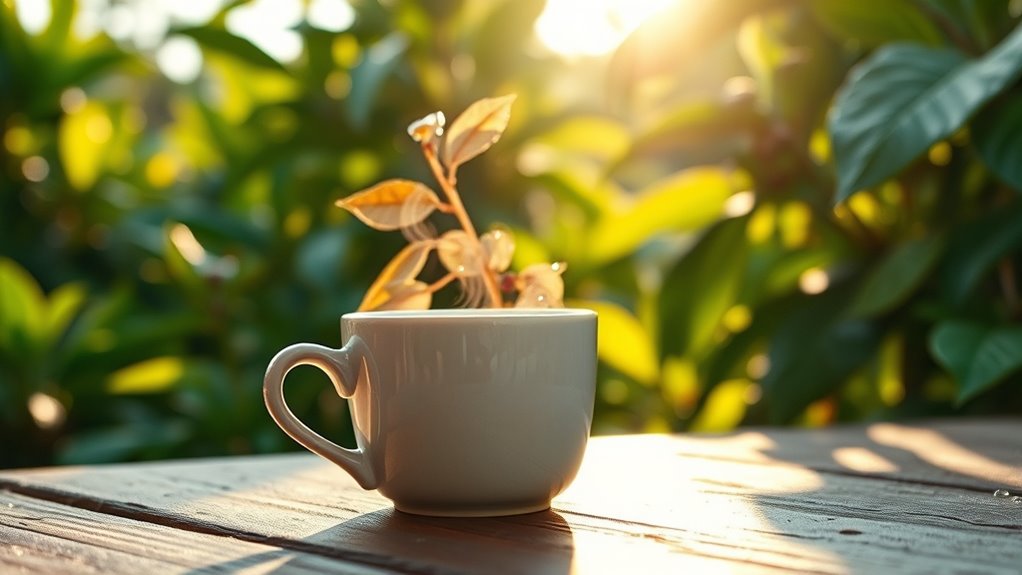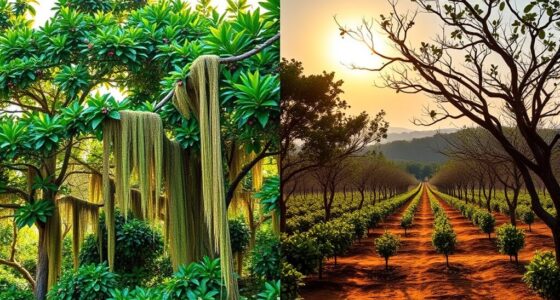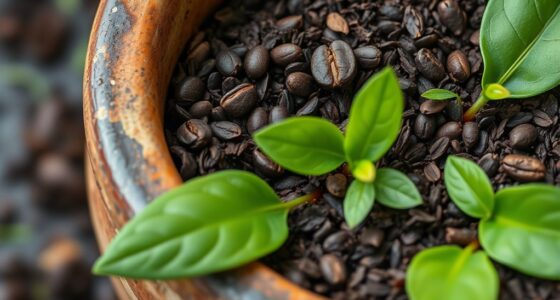The water footprint of your cup begins on farms, where growing coffee and tea often needs significant water, especially with irrigation and processing. Water is also used during cleaning, drying, and brewing, and some water gets recycled or reused to cut waste. Every step, from cultivation to your café, adds to the total water used. If you keep exploring, you’ll discover how choosing sustainable options can help reduce this important environmental impact.
Key Takeaways
- The water footprint includes water used during cultivation, processing, transportation, and brewing of coffee or tea.
- Water consumption varies based on farming methods, such as irrigation practices and rainwater harvesting.
- Processing stages like washing and drying require significant water, which can be reduced with efficient equipment and recycling.
- Brewing at cafés involves measuring and equipment choices that influence overall water use.
- Supporting sustainable brands and water-efficient practices helps minimize the total water footprint from farm to cup.

Have you ever wondered how much water goes into making a simple cup of coffee or tea? It’s surprising to realize that each sip involves a considerable amount of water, from the farm where the beans or leaves are cultivated to the café where you enjoy your drink. Understanding the water footprint of your favorite beverage helps you see the importance of sustainable brewing and water conservation methods. When you choose to be mindful of how your drink is made, you’re supporting efforts to reduce unnecessary water use and promote eco-friendly practices.
The journey of water in your cup begins at the farm, where coffee and tea plants require substantial water to grow healthy and flavorful. Farmers often rely on irrigation, especially in areas facing water scarcity, which can deplete local water sources if not managed carefully. This is where sustainable brewing practices start even before the coffee beans or tea leaves reach your cup. Farmers adopting water conservation methods, such as drip irrigation or rainwater harvesting, help minimize water waste and protect local ecosystems. These efforts ensure that the water used in cultivation is optimized, reducing the overall water footprint of your beverage.
Once harvested, the beans and leaves go through processing, which also consumes water. Washing, cleaning, and drying processes demand water, and employing water-efficient equipment can make a big difference. When you choose brands or cafés that prioritize sustainable brewing, you’re indirectly supporting these water conservation methods. These establishments often implement practices such as reusing rinse water, installing low-flow fixtures, or recycling wastewater to cut down on water use. As a conscious consumer, your preference for establishments that focus on sustainable brewing helps push the industry toward more responsible water management.
During brewing, many people overlook the importance of water conservation, but it’s a critical step. Simple adjustments, like using the right amount of water, investing in efficient brewing equipment, and avoiding waste, can noticeably lower your water footprint. Some cafes even implement water-saving brewing techniques, such as using water filters that reduce waste or opting for brewing methods that require less water altogether. By being aware of these practices, you can make choices that support water sustainability and reduce your environmental impact.
Finally, the water used in your cup isn’t just about the amount of water consumed directly; it also encompasses the water embedded in the entire supply chain. Recognizing this helps you appreciate how your simple act of drinking coffee or tea can contribute to global water conservation efforts. Supporting brands committed to sustainable brewing and water-saving initiatives not only improves the water footprint of your favorite drinks but also encourages a more responsible approach across the industry. By making informed choices, you help promote a future where enjoying your beverage doesn’t come at the expense of our precious water resources.
Frequently Asked Questions
How Is Water Footprint Measured for Different Coffee Varieties?
You measure the water footprint of different coffee varieties by evaluating water usage during cultivation and processing. You consider factors like irrigation needs, rainfall, and soil moisture, which vary with cultivation practices. By analyzing data from farms and processing plants, you determine how much water each variety consumes from farm to harvest. This helps you compare environmental impacts, encouraging sustainable choices based on water efficiency and cultivation methods.
Does Organic Farming Reduce the Water Footprint of Coffee?
Yes, organic farming can reduce the water footprint of coffee. By focusing on water conservation and implementing efficient irrigation practices, organic farmers often use less water and avoid chemical runoff that can harm water sources. These practices help maintain soil health and reduce the need for excessive watering. As a result, organic coffee tends to have a lower water footprint, making it a more sustainable choice for eco-conscious consumers.
How Does Climate Change Impact the Water Footprint of Coffee Production?
You see climate change intensify, causing unpredictable rainfall variability that affects coffee farms. As droughts or floods become frequent, you’ll notice farmers needing climate adaptation strategies, like new irrigation methods or drought-resistant plants. These shifts increase water use, raising the coffee’s overall water footprint. Changes in rainfall patterns directly influence water availability, making sustainable practices more vital to keep your favorite brew environmentally friendly amidst a changing climate.
Are There Alternative Beverages With Lower Water Footprints?
Yes, you can choose beverages with lower water footprints, like herbal teas or infused water. Opt for drinks made with sustainable packaging and support water conservation methods in production. By selecting these options, you help reduce overall water use and promote eco-friendly practices. Switching to such beverages also encourages cafes to adopt sustainable measures, making a positive impact on water resources and the environment.
Can Consumers Influence Water Sustainability in Coffee Production?
Think of yourself as a gardener, planting seeds of change. Your consumer awareness can influence water sustainability in coffee production by choosing beans from farms practicing water conservation strategies. When you opt for ethically sourced coffee, you’re watering the roots of sustainable farming. Your choices ripple through the supply chain, encouraging better water management. Yes, your mindful buying can foster more sustainable coffee practices and help conserve precious water resources.
Conclusion
Every sip you take is like a tiny ripple in a vast water ocean, reminding you that your coffee’s journey from farm to café is woven with countless drops. By choosing mindful sips, you become a guardian of this precious resource, turning each cup into a proof of care. So, next time you reach for your brew, remember—you hold the power to make waves of change, one cup at a time.








